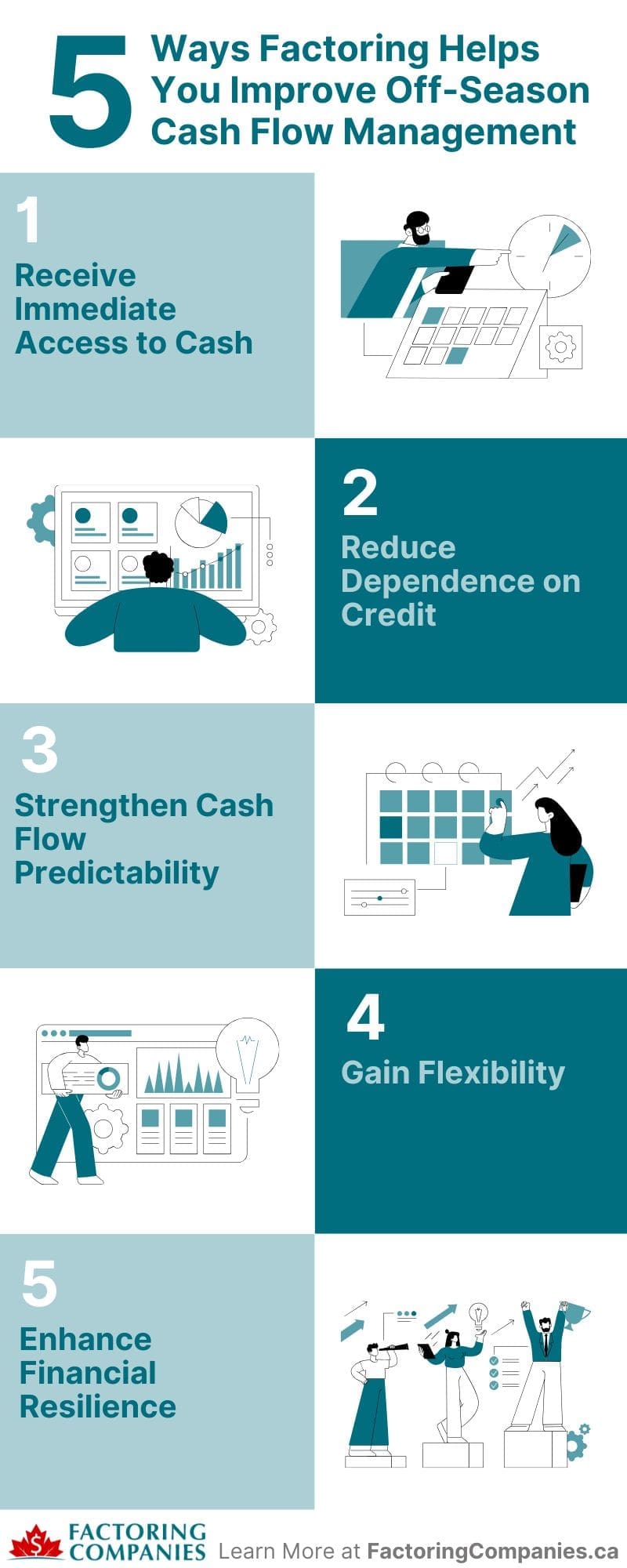
Nearly three-quarters of small-to-midsize businesses have had to deal with at least some cash flow issues in the past year, according to Xero. However, those with seasonal swings are much more likely to face challenges and are likely to feel their impacts more deeply. In this guide, we’ll walk you through why it happens, what you can do about it, and how seasonal business invoice factoring fits into the picture.
Off-Season Cash Flow Challenges Have Wide-Ranging Impacts
Seasonal shifts are a normal part of business for many industries across Canada. However, a slowdown in revenue does not mean your financial obligations ease. Managing cash flow during off-peak periods requires a different kind of planning and discipline to ensure your business stays resilient and ready for growth when the next busy season returns.
Many Factors Contribute to Tighter Cash Flow During the Off-Season

When business activity slows, it can quickly put pressure on your working capital. Fixed costs like payroll, rent, insurance, and supplier contracts continue, even when incoming payments drop. Without a clear plan to bridge the gap, short-term slowdowns can lead to long-term financial strain.
- Reduced Revenue Cycles: Fewer sales transactions mean less cash is coming in, even though your core expenses remain constant.
- Extended Payment Terms: Customers may also slow down their payments during quieter periods, lengthening your receivables cycle.
- Inventory Holding Costs: Businesses carrying seasonal stock may face higher warehousing, insurance, and handling expenses while waiting for the next selling opportunity.
- Ongoing Operational Expenses: Utilities, employee wages, equipment leases, and administrative costs continue, regardless of seasonal fluctuations.
Off-Season Cash Flow Pressures Halt Essential Activities
A slowdown in cash flow can ripple across your business operations in many ways. You may struggle to:
- Pay Vendors on Time: Delayed payments to suppliers can strain relationships and may limit your access to critical inventory or materials when you need them most.
- Meet Payroll Consistently: Difficulty covering wages can impact employee satisfaction, morale, and retention during a time when stability matters most.
- Pursue Growth Opportunities: Limited cash reserves can prevent you from capitalizing on opportunities like early payment discounts, equipment upgrades, or expansion efforts.
- Manage Debt Effectively: Missed loan or credit payments can lead to higher borrowing costs and weaken your company’s financial position over time.
A Wide Range of Industries Are Affected by Seasonal Cash Flow Challenges
While almost any business can experience cash flow pressure, it is particularly common in industries where revenue is tied closely to seasonal demand. In sectors like these, understanding and managing the off-season becomes a critical part of long-term success.
- Transportation and Trucking: Freight volumes often decline after major shipping seasons, such as the post-holiday period, putting pressure on trucking companies to cover fuel, maintenance, and insurance costs with fewer billable miles.
- Construction: Harsh Canadian winters shorten the building season in most provinces, leaving construction firms to manage heavy equipment costs, labour expenses, and fixed overheads even when projects pause.
- Staffing and Recruitment: It’s common for temporary employment agencies to see surges tied to tax season, the holiday retail rush, and summer contracts, followed by stretches where demand is considerably lower.
- Wholesale and Distribution: It’s typical for wholesale companies focused on seasonal goods, such as holiday decorations, sporting goods, or recreational equipment, to experience compressed revenue periods followed by longer stretches with slower sales.
How to Manage Cash Flow During Off-Season
Managing cash flow during slower months starts long before sales decline. Businesses that navigate the off-season most effectively are the ones that treat it as part of their year-round strategy, rather than a last-minute scramble.
Build a Strong Cash Reserve
Set aside a portion of peak-season profits to create a financial cushion for slower months. Even modest, consistent contributions can make a meaningful difference when cash inflows drop.
Review and Adjust Your Budget
Do not rely on annual budgets alone. Build seasonal budgets that account for slower periods, adjusting discretionary spending and deferring non-essential expenses when needed.
Strengthen Receivables Management
Invoice promptly and follow up on outstanding payments more aggressively during the off-season. Tightening your collections process can help improve cash inflows without taking on new risk.
Negotiate with Suppliers and Partners
Some suppliers may be willing to extend terms or offer seasonal flexibility if you ask early. Maintaining strong vendor relationships can give you more room to manage outgoing cash flow.
Diversify Revenue Streams
Many businesses find success by introducing secondary offerings that generate revenue during slower months. This could include maintenance contracts, consulting services, or complementary products.
Use Short-Term Financing Strategically
In some cases, short-term financing can help bridge temporary gaps. Options like lines of credit, seasonal business loans, and invoice financing are common tools. However, it is important to evaluate the cost and structure of any funding carefully before proceeding.
Improve Off-Season Cash Flow Management with Invoice Factoring

When the off-season slows incoming revenue, managing your cash position becomes critical. Factoring gives businesses a way to unlock working capital tied up in receivables, making it easier to cover ongoing expenses without taking on additional debt. Rather than waiting for customers to pay on extended terms, you can access most of the invoice value up front, smoothing out your cash flow during slower months. Because of this, it can support your off-season strategy in several important ways.
Receive Immediate Access to Cash
Factoring turns your unpaid invoices into working capital, allowing you to meet payroll, pay suppliers, and manage expenses without delay.
Reduce Dependence on Credit
Because factoring is not a loan, it preserves your access to traditional credit lines for other business needs, such as growth investments or emergency reserves.
Strengthen Cash Flow Predictability
With faster access to funds, you can plan budgets more accurately, maintain consistent operations, and avoid last-minute financial pressures.
Gain Flexibility
Factoring is flexible, allowing you to factor more invoices during slower periods and scale back when cash flow improves, without committing to long-term financing.
Enhance Financial Resilience
Having access to factoring during the off-season can help you maintain supplier relationships, retain key employees, and position your business for a stronger start when demand returns.
Get Started with Seasonal Business Invoice Factoring
If invoice factoring seems like the ideal solution to your seasonal cash flow challenges, explore the fit more with a complimentary rate quote.
FAQs on Seasonal Business Invoice Factoring
Is invoice factoring a good option for seasonal businesses?
Factoring can be a strong option for seasonal businesses that invoice other companies and experience predictable slow periods. It offers flexible, debt-free financing based on accounts receivable, helping businesses manage ongoing expenses and prepare for peak seasons without taking on new liabilities.
What are the benefits of factoring invoices during the off-season?
Factoring invoices during the off season provides quick access to cash, improves budgeting predictability, preserves credit lines for other needs, and supports steady operations when sales slow. It allows businesses to maintain financial stability and invest in preparing for the next busy season.
When should a seasonal business consider using invoice factoring?
A seasonal business should consider factoring when receivables are tied up, cash flow is tightening, and operational expenses must still be met. It is especially useful when delayed customer payments threaten payroll, supplier relationships, or preparation for upcoming peak periods.
How does invoice factoring compare to a line of credit for seasonal businesses?
Invoice factoring provides funding based on outstanding invoices, while a line of credit is based on your business’s credit profile and financial history. Factoring is typically faster to access, does not add debt, and adjusts with sales cycles, making it attractive during seasonal slowdowns.
What types of seasonal businesses use invoice factoring?
Industries such as transportation, construction, staffing, agriculture, and wholesale distribution often use factoring. These sectors experience predictable revenue swings and depend on invoicing other businesses, making factoring a natural fit to stabilize cash flow during quieter months.
Can a small seasonal business qualify for invoice factoring?
Yes, small seasonal businesses can often qualify for factoring if they have strong commercial customers. Approval typically depends more on the creditworthiness of the customers being invoiced than on the business’s size or financial history, making it accessible even to newer companies.
How quickly can a seasonal business get funding through factoring?
Factoring is designed for speed. Once approved, a seasonal business can often receive funding within one to three business days. Initial setup may take slightly longer, but future advances against invoices are usually processed very quickly.
What risks should seasonal businesses know about before factoring invoices?
Seasonal businesses should understand that factoring fees reduce the total value received from invoices and that strong customer payment performance is critical. It is important to review contract terms carefully, especially regarding minimums, reserves, and notification policies with customers.
How much does invoice factoring cost for seasonal businesses?
The cost of factoring typically ranges from one to five percent of the invoice value, depending on customer credit strength, invoice volume, and the factoring company’s terms. Costs can vary, so it is important to compare providers and understand the full fee structure.

About Factoring Companies Canada
Related Articles
Get an instant factoring estimate
Factoring results estimation is based on the total dollar value of your invoices.
The actual rates may differ.
CLAIM YOUR FREE FACTORING QUOTE TODAY!
PREFER TO TALK?
You can reach us at
1-866-477-1778
Get an instant factoring estimate
Factoring results estimation is based on the total dollar value of your invoices.
The actual rates may differ.
CLAIM YOUR FREE FACTORING QUOTE TODAY!
PREFER TO TALK? You can reach us at 1-866-477-1778











